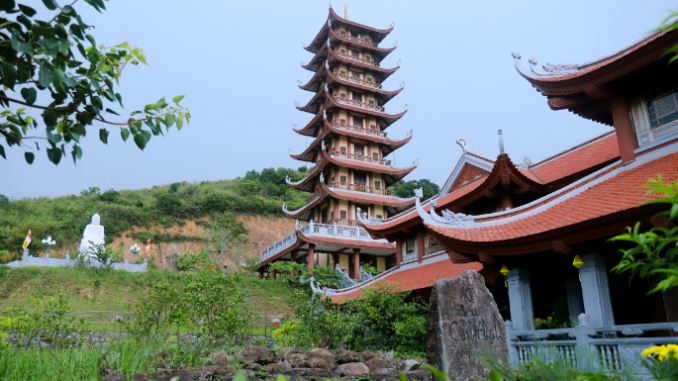
NGHE AN – Dai Tue Pagoda is located on the top of Dai Hue Mountain 500 m high, with an artificial lake, a calligraphy couplet system, and ruby and mulberry wood statues that are recognized as Vietnamese records.

Dai Tue Pagoda is 6,000 m2 wide, located on top of Thang Thien cave, in the Dai Hue mountain range, Nam Anh commune, Nam Dan district, at an altitude of 500 m above sea level, is a famous landscape of Nghe An.
Legend has it that the pagoda dates back to the time when King Mai Hac De defeated the Tang army (627 AD). In the 15th century, the structure was rebuilt by King Ho Quy Ly to worship Buddha Dai Tue, who helped the Ho dynasty build Dai Hue citadel as a base against the Ming invaders.
In 1789, on his way to the North to defeat the Qing army, King Quang Trung stopped in Nghe An, recruited soldiers and organized training in front of the pagoda yard. The monk advised the king on the military strategy, avoiding the enemy’s eyes and ears as well as shortening the route to Thang Long. After ascending the throne, the king decided to cut 20 acres of field and give it to Dai Tue pagoda so that the villagers could take care of incense and worship all year round.
Through the changes of time, Dai Tue Pagoda only has 3 mossy walls and a thatched roof left. In 2011, the project was rebuilt with 4 parts including Trinh, Lower, Middle and Upper pagodas.

The works were completed after 4 years of construction. The entrance to the pagoda is a three-entrance gate with 3 tiled roofs and stylized patterns. Buddhists and tourists standing from the gate can observe the entire architectural work behind.

In front of the main gate and some positions in the temple yard are placed Arhat statues made of monolithic stone, over 2 meters high. Below the statues are engraved verses advising people to live a good life.

Items at the pagoda include the palace hall, the temple hall, the Five Emperors church, the hall memorial house, the monkhood area… each project’s area ranges from 250-1,200 m2.

The outstanding architectural work at the pagoda is the 9-storey Dai Tue stupa, 32 m high, worshiping Buddha and national heroes.
On the side of the way up to the tower is a tomb built of stone. Legend has it that, when Emperor Canh Thinh (King Quang Toan, son of Quang Trung), was chased by the Nguyen army, he ran to Dai Hue mountain and became a monk at Dai Tue pagoda. When he died, Canh Thinh was buried by people and built a grave here.

Inside the 9-storey stupa, dozens of monolithic ruby statues are displayed.

At the main hall, the ancestral hall and the Five Emperors Church, there are 32 Buddha statues made from solid mulberry wood. Around the palaces, there is a system of parallel horizontal panels with pure Vietnamese calligraphy.

To the right of the palaces is the 350 m2 Tien Lake, contributing to regulating the landscape and spatial environment around the pagoda.
On February 19, 2016, the Vietnam Record Holders Association confirmed 4 Vietnamese records for Dai Tue Pagoda, including: the pagoda with the most ruby statues, the most monolithic mulberry wood statues, and the system of parallel sentences. with the most pure Vietnamese calligraphy and the mountain pagoda has the largest artificial lake.

The paths around the campus are paved. Some pagoda locations arrange miniature landscapes during holidays and New Year to serve check-in.

The temple yard is planted with many trees, under the canopy are arranged stone and iron chairs for Buddhists and pilgrims to sit, rest, enjoy the cool air, and chat…

From the pagoda, visitors can “hunt clouds”, watch the winding roads around the Dai Hue mountain range and the countryside scenery in Nam Dan district.

Under Dai Hue Mountain, there are many gardens of rose eggs and roses, and this is the time of harvest. Tourists coming to pilgrimage and sightseeing at Dai Tue Pagoda often stop by to check in and take commemorative photos under the ancient rose trees.
Photo,Video: Internet (Vinlove.net)
